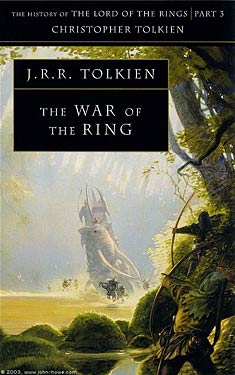JRR Tolkien
Completed 7/14/2019,
Reviewed 7/14/2019
4 stars
It’s been
over a year and a half since I last read a book in the History of Middle Earth (HoME)
series. So it was time to pick up the
next in the series, the eighth. “The War
of the Ring” is also the third in the subseries of the History of the Lord of
the Rings. This book was a tougher start
than most of the other books in this series that I’ve read. I had a lot of trouble getting back into the
swing of the purpose and format of the book.
It was probably because this book begins with the conclusion of the battle
of Helm’s Deep and it had been so long since I had read the beginning of
it. Nonetheless, I eventually got into
the rhythm of the book and settled down into a week and half of heavy but
informative and interesting reading.
 This book
takes us through the second half of The Two Towers and the first half of TheReturn of the King. It follows Frodo
and Sam from their meet up with Gollum and goes through their confrontation
with Shelob. Shelob was initially
Ungoliant, the ultimate evil spider from the The Silmarillion and other HoME books. Instead Tolkien chose to make the spider one
of Ungoliant’s children. As always, this
book is filled with origin texts and manuscripts, so we get a lot of the development
of the characters, the plots, the dialog, and the world-building.
This book
takes us through the second half of The Two Towers and the first half of TheReturn of the King. It follows Frodo
and Sam from their meet up with Gollum and goes through their confrontation
with Shelob. Shelob was initially
Ungoliant, the ultimate evil spider from the The Silmarillion and other HoME books. Instead Tolkien chose to make the spider one
of Ungoliant’s children. As always, this
book is filled with origin texts and manuscripts, so we get a lot of the development
of the characters, the plots, the dialog, and the world-building.
We also
spend time with the rest of the Fellowship, in Rohan and Gondor and along the way
in between. We are introduced to
Faramir, who initially is not Boromir’s brother. But as Tolkien writes the text, it just
appears that he is Boromir’s brother and he becomes an important part of the
plot. Eowyn shows up from the Rohan parts of the
story. Initially, a romance was supposed
to blossom between her and Aragorn, as there is still almost no mention of the
existence of Arwen. She was also
supposed to die in the original drafts, but Tolkien changed his mind, as he did
so much during the development of the book.
A lot of time is also spent on the palantirs. It took a while for Tolkien to figure out
just what these seeing stones did and didn’t do.
Christopher
Tolkien spends a lot of time on the geography and chronology that his father
struggled with during the writing of LOTR.
Some of that got quite boring, particularly the dates. But it showed me how much effort his father
took in getting the internal world-building right. This is most evident in the depiction of the
phases of the moon. With the breakup of
the Fellowship, it was important that when references to moon were made that
they were internally consistent based on how many days away they were from each
other. The geography changes also got a
little tedious. The names of the
locations changed a lot, just as they did in the development of the First Age
in the early books of the HoME series.
And their positions on the map changed quite often. I can see how Tolkien was so concerned with
the minutiae of his world that every detail be just right. It makes one wonder how Tolkien ever got
anything published, let alone this epic tale of fifteen hundred pages. It also makes one realize why he never
published “The Silmarillion” in his lifetime.
He included so much detail in his original world that he could not get
it just right.
I give the
book four stars out of five. Once again,
I followed the book along with most of the discussions by The Tolkien Professor,
Corey Olsen, and it really helped me understand and appreciate the book more
than I think I would have just reading it alone. And once again, I only recommend this book
for the die-hard fan who is interested in a detailed behind the scenes look into
the world of Middle Earth. I’m still
really enjoying it and look forward to the conclusion of the Lord of the Rings subseries
in the HoME series.
No comments:
Post a Comment